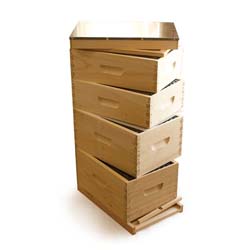In our previous lesson, we looked at why queen rearing can be a fascinating, fun, and worthwhile opportunity for the beekeeper. We now look at one of the more popular approaches to queen rearing, called grafting, at an introductory level.
While queen rearing isn’t necessarily the right path for the absolute beginner beekeeper, it is a skill that pays big dividends over time. From the outset, the new beekeeper should keep an open mind to this being a viable and useful option as experience grows.
You may recall we can create a new queen with a split, letting the colony create their own queen. While this works, rearing queens using other methods is a more efficient way to create queens, for two important reasons.
- Queen rearing provides the opportunity to create more than one queen at a time
- It doesn’t put all the eggs – excusing the pun! – in one basket, as is the case with a split and where the queen may not even return from her mating flights
In a nutshell, queen rearing scales better and reduces the risk of having nothing to show for your efforts.
Grafting Overview
Grafting is a very common approach to queen rearing and is used by commercial beekeepers as an efficient and quick way to raise queens. It has the potential to create tens of queens through the same process. Some aspects require a little finesse (and good eyesight!) and not all attempts will be successful. But with some fortitude and attention to detail, grafting can be successfully used by any beekeeper.
Here are the main steps to grafting.
- Locate very young larvae in a hive
- Transfer them to artificial queen cups
- Move the artificial queen cups to a cell builder colony
- Just before the first queen is about to emerge, move all the queen cups to their own individual queenless colonies
Let’s look at each of these steps in more detail.
Locate Very Young Larvae
The first step is to look for very young larvae in a hive. It is essential that these larvae are as young as possible. If they pass beyond their 3rd day and royal jelly is no longer being fed to them, they cannot subsequently develop into queens. The plan, therefore, is to move larvae before their third day, so that the workers in the cell builder colony (see below) can continue to feed royal jelly past their third day.
The source larvae should be taken from one of your strongest hives, which helps create a genetic line with good characteristics.
Transfer to Artificial Queen Cups
Once you have located young larvae (many of which will be close to each other on the frame, since the queen laid them around the same time), the next step is to extract them from their cells and place in artificial queen cups.
This is the most delicate part of the operation.
Since the larvae required are very small, this process takes a very steady hand and keen eyesight (many beekeepers use magnifying glasses to help with that).
The artificial queen cups are generally held together on a frame so that many larvae can be transferred and moved easily. It isn’t unusual to transfer 30 or more larvae in this way.
Place Artificial Queen Cells in Queenless Cell Builder Colony
The artificial queen cells are then placed into a queenless hive. The workers in this hive will feed the larvae. Workers tend to consider vertically-hanging cells as developing queens and will therefore feed royal jelly beyond the larvae’s third day. The queens develop from larvae to pupae, with many in the same hive.
As the larvae turn to pupae and approach the time they would emerge from their cells, the beekeeper has to step in. Things would go bad if any of these queens emerged from her queen cup since her first job would be to hunt down the other queens in the hive and kill them. Therefore, there is one more step necessary.
Move Individual Queens to Separate Mating Nucs
Before any of the queens have emerged from the queen cups, they are moved into separate nucs. This will be done after about 10 or so days.
When the queens emerge, each is in her own colony – as the only queen – and she can thus continue without being threatened by other queens. Her next step will be to carry out her mating flights and then continue on as the queen for that hive.
Because there can be some losses of the queen, mating nucs should be quite small.
Here’s an excellent video from our friends at the University of Guelph illustrating grafting.
